What are the defining characteristics of lace knitting/knitted lace?
The essential building block of a knitted lace fabric is a 1 or 2 stitch decrease accompanied by a yarn over (an eyelet hole) to replace the stitch(es) lost in the decrease. The essential structure of hole and decrease can be arranged in various ways in pattern shapes, usually, but not always, geometrically based in order to create fabrics which are visually pleasing. Often, there is an attractive textural feature as well.
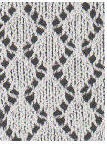
The most common and easiest to knit lace structure is stocking stitch-based, where the patterning takes place only on the knit (right side) row. The second and all even rows are purl-based. When the eyelets (holes) are arranged diagonally and are adjacent to a decrease which follows the same diagonal direction, the space between the holes is spanned by a herringbone cross link of 2 strands. This is known as “faggoting” and is one of the most open of pattern every alternate row (PEAR) fabrics. See Open Diamond patterns on the left. Faggoting can also occur along a vertical line of holes.
“Simple” and “Fashioned” Knitted Lace
These are terms borrowed from domestic machine knitted lace, since hand knitting does not have any terms to differentiate between a yarn over and adjacent decrease (or the other way round), which machine knitters call “simple”, and “fashioned” whereby the decrease is delayed and is separated by several stitches, causing the stitches to lean in the direction of the decrease, the choice of which can accentuate the lean.
In more complex lace patterns, where curve and texture are considerations, these decreases can be delayed by several rows. On Japanese charts, the symbols // \\ show the direction of the lean in “fashioned” lace patterns. They do not represent an action to be taken. In other charting systems, those leaning symbols stand for decreases, and lean is not shown at all.
In the following exercises, only the symbols for the patterns offered for beginner lace knitters are given.
To find out more, please look up Paint for Charting Knitting Patterns and Key to Knitting Symbols on the Guild web site. The articles in 2013 issues of Slipknot on the Guild Collection’s 1891 Victorian Sampler cover a wide selection of lace knitting techniques in a selection of lace patterns from that Sampler. The high quality and variety of the patterns, are evidence of a gifted and inventive lace knitter. Charts and written instructions accompany the majority of the patterns.
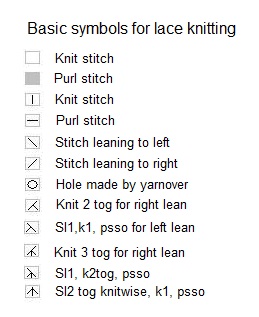
Lace Knitting Techniques
From the list of basic symbols you will see that knit and purl stitches may be shown in different ways in lace knitting patterns, perhaps depending on whether the pattern is of hand or machine knitting. In this section instructions are given for hand knitters starting on lace knitting.
Yarn over on the knit side
Symbol: O on the chart shown 7th in list. A blank mini grid is a knit stitch. Only the knit rows are represented on the chart. Read the repeat from right to left, as you would knit the row. To do a yarn over on the knit side, with the yarn at the back lift the yarn under the needle, then around. As you knit the next stitch, the yarn slopes over the right needle. That is a yarn over, the basis of the new stitch over the lace hole.
Single right-leaning decrease
Symbol is a right leaning stroke supported by a small one, shown 8th on the list. This is made by knitting the next 2 stitches together. This can be tough if you are a tight knitter, if your needles are too small, and if your needles have not got tapering ends. Abbreviation: k2tog.
Single left-leaning decrease
Symbol is a left leaning stroke supported by a small one, shown 9th on the list on the left. This can be accomplished in 2 ways:
- Slip the next stitch, knit the next one and pass the slipped stitch over. Abbreviations: sl1,k1, psso OR skpo. NB: This is the older of the 2 forms and will be the one used in pre-1960s written patterns.
- Slip the next 2 stitches, singly and knitwise, on to the right needle. Insert the left needle into the front of the stitches and knit off as one stitch. This is easier & quicker to accomplish than skpo. Abbreviation: ssk
Double left leaning decrease
This is the most common double decrease used in hand-knitting. The symbol is a mixture of the left leaning single decrease with the addition of a small vertical stroke, shown 11th on the list. To work it : slip the stitch, knit the next 2 stitches together and pass the slipped stitch over. Abbreviation: sl1,k2tog,psso
Other Abbreviations
rs = rows, sts = stitches. PEAR = pattern every alternate row, DDR = delayed decreases along the row. If you are helped by visual stage by stage, hands on illustrations, please visit the Japanese symbols website (English instructions) ssk however, is not illustrated, but look elsewhere for that on the Internet.
Simple Lace Patterns to Try
The patterns selected here as an introduction to lace knitting by hand, are graded and are chosen to give practice for the few techniques required. Suggestion: knit swatches appropriate for the size of the repeat+ 2 knit stitches at each selvage. Then study the structure of the pattern and note how it has been achieved.
Broken Pairings – a problem to deal with (see patterns 2, 3 & 4)
Usually, a yarn over must be paired with a decrease, to keep the complement of stitches correct in a row. (The places to check are the left and right selvages of the swatch, or in real terms, a garment or article). If one or the other is missing, you must take a step to remedy it. You can alter a yarn-over with no decrease, a single decrease with no yarn over to a knit stitch, and a double decrease to a single. Whatever you do, keep the right complement of stitches. NB. Only one pattern repeat is written. Work with the chart as well.
Needles and Yarn
Try first with the usual size needles you would choose for the yarn. Often a larger size works best, especially if you are a tight knitter. Fashioned lace patterns usually work better with finer yarns.
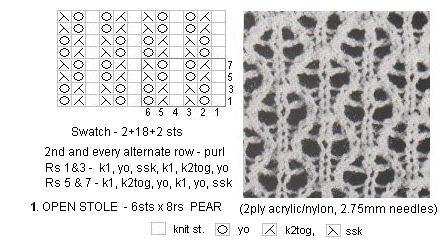
1. Open Stole
This is from the machine knitting tradition. It is about the easiest pattern to try and is a very attractive one too. Anyone hesitant about attempting lace knitting should be won over by this one. The pattern provides practice for yarn overs and for the 2 single decrease techniques.
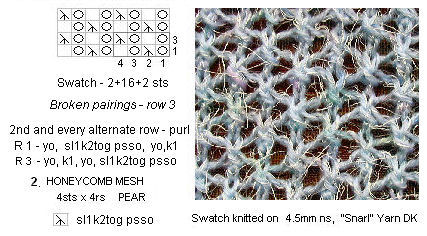
2. Honeycomb Mesh
This is an old pattern, popular in framework, hand knitting and machine knitting often as a background for solid stocking shapes or as a shawl centre (Shetland). It is good choice for DK, “interest” and hairy yarns. The pattern provides practice for double decreases only.
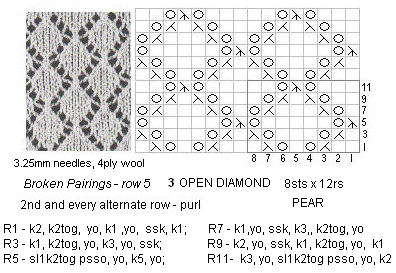
3. Open Diamond
This is probably the oldest and most well-known of any here. All 3 techniques are in use.
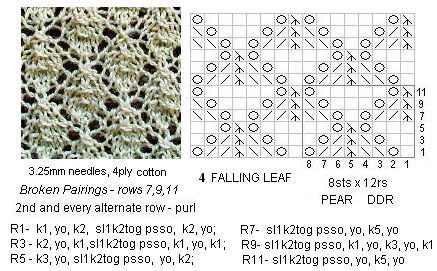
4. Falling Leaf
This is a Fashioned Lace Pattern to try. This pattern was a favourite with Victorian lace hand knitters. The placement of the holes is exactly the same as for Open Diamond, but look what happens when the decreases are delayed along the row. Note how the leaning strokes represent the direction of the stitches towards the decrease.

